Boeing 747: in all its iterations, probably the best-known heavy jet, with maximum take-off weights of as much as 975,000 lbs (442,250 kg) (proposed for the new 747-8). I started out with the thought that I would include a picture of each carrier who brings B747's into LAX, but after I started assembling the list, I realized that there are over two dozen different operators of B747's here. To keep this entry somewhat manageable, I'll make do with a sampling:
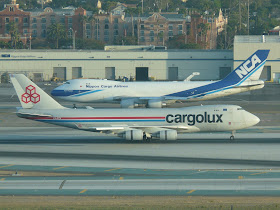









 B747-400: 910,000 lb (412,775 kg). The most-frequently-seen model of 747 at LAX is the only 747 with winglets; Cargo models have the short fuselage hump, while Passenger models have the long fuselage hump. We're also now seeing long-hump cargo conversions of former passenger aircraft (last photo).
B747-400: 910,000 lb (412,775 kg). The most-frequently-seen model of 747 at LAX is the only 747 with winglets; Cargo models have the short fuselage hump, while Passenger models have the long fuselage hump. We're also now seeing long-hump cargo conversions of former passenger aircraft (last photo).
 B747-300: 833,000 lb (377,840 kg). The first version to have the extended fuselage hump can be discerned from the later -400 by the lack of winglets.
B747-300: 833,000 lb (377,840 kg). The first version to have the extended fuselage hump can be discerned from the later -400 by the lack of winglets.


 B747-200: 833,000 lb (377,840 kg). All the -200's that we see at LAX these days are freighters. The last isn't a very good photo, but this was the very last take-off for this particular aircraft, seen here leaving LAX for the salvage yard in Arizona; I think it deserves to have its picture here.
B747-200: 833,000 lb (377,840 kg). All the -200's that we see at LAX these days are freighters. The last isn't a very good photo, but this was the very last take-off for this particular aircraft, seen here leaving LAX for the salvage yard in Arizona; I think it deserves to have its picture here. B747-100: 735,000 lb (333,390 kg). Kalitta Air is the only operator I've noticed at LAX with a -100 model recently, although I believe both of these are -200's.
B747-100: 735,000 lb (333,390 kg). Kalitta Air is the only operator I've noticed at LAX with a -100 model recently, although I believe both of these are -200's. B747SP: 670,000 lb (304,000 kg). The rarest of the 747 family; only 45 were built and maybe a third of those are still flying.
B747SP: 670,000 lb (304,000 kg). The rarest of the 747 family; only 45 were built and maybe a third of those are still flying.Boeing 777: A number of carriers are replacing (or already have done) their B747's with B777's in passenger service. At LAX, this includes Cathay Pacific, EVA, Japan Air, Malaysia, Asiana, Korean, All Nippon, El Al, Air France, and United. American and Delta replaced their MD-11's with B777's. Curiously, the domestic carriers all have -200's; the -300's we see are all foreign carriers (some of whom also have -200's).
Boeing 767


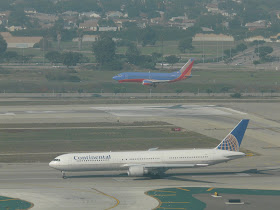 Boeing 767-400: 450,000 lb (204,120 kg). Delta and Continental are the only US operators of the -400 model; at one time both of these carriers operated all three versions of the 767. Although Delta no longer uses -200's, they do currently have the world's largest fleet of B767's (102).
Boeing 767-400: 450,000 lb (204,120 kg). Delta and Continental are the only US operators of the -400 model; at one time both of these carriers operated all three versions of the 767. Although Delta no longer uses -200's, they do currently have the world's largest fleet of B767's (102).Boeing 757-300
UPDATE: The B753 is no longer considered a Heavy. See this entry.


 B757-300: 123,600 kg (272,500 lb). Only two carriers bring B753's into LAX: Continental and Northwest (who's now becoming part of Delta). In the last shot you can see a smaller Northwest -200 alongside; this shot was taken before Northwest relocated to Terminal 4.
B757-300: 123,600 kg (272,500 lb). Only two carriers bring B753's into LAX: Continental and Northwest (who's now becoming part of Delta). In the last shot you can see a smaller Northwest -200 alongside; this shot was taken before Northwest relocated to Terminal 4.Boeing 707: Surprise! The 707, one of the original jetliners from the 50's, is a heavy. We don't see them very often any more, as most ended up as spare parts for the Air Force's fleet of KC-135's. These are the two that do make occasional appearances at LAX:



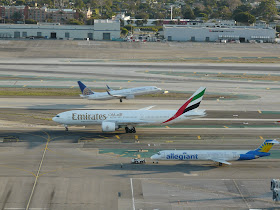


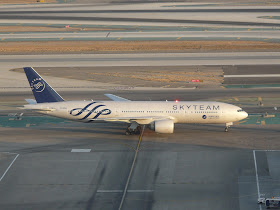






















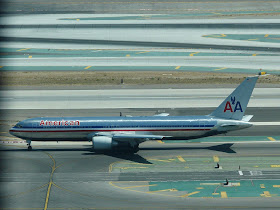


Those are some really good airplane pictures! I especially like the take-off and landing shots. It often looks as if the tail should be dragging the ground. Also impressive is the number of 747 pictures you took with two of them in the same shot.
ReplyDeleteN